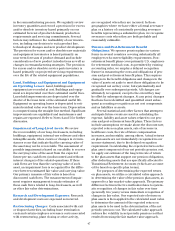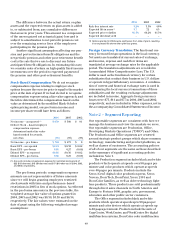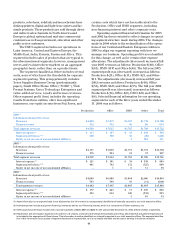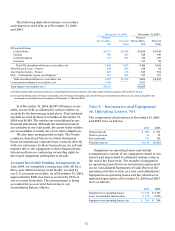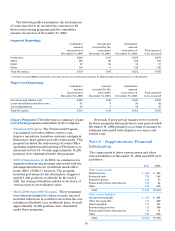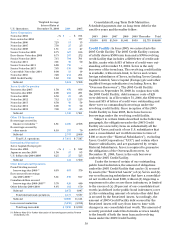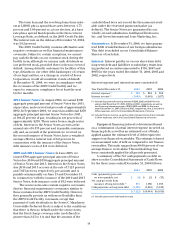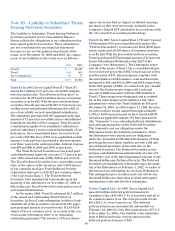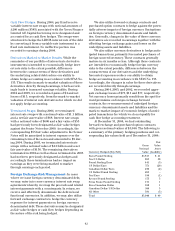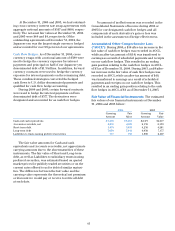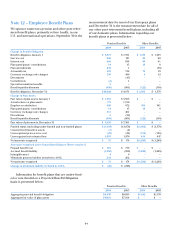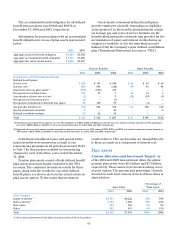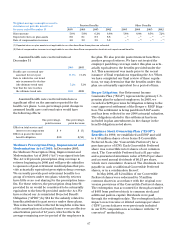Xerox 2004 Annual Report Download - page 59
Download and view the complete annual report
Please find page 59 of the 2004 Xerox annual report below. You can navigate through the pages in the report by either clicking on the pages listed below, or by using the keyword search tool below to find specific information within the annual report.
57
The components of other long-term assets and
other long-term liabilities at December 31, 2004 and
2003 were as follows:
2004 2003
Other long-term assets
Prepaid pension costs $ 891 $774
Net investment in discontinued operations 440 449
Internal use software, net 255 307
Restricted cash 160 343
Investments in non-affiliated companies —104
Financial derivative instruments 19 89
Debt issuance costs, net 64 79
Other 271 332
Total other long-term assets $2,100 $ 2,477
Other long-term liabilities
Deferred and other tax liabilities $ 862 $809
Minorities’ interests in equity of subsidiaries 80 102
Financial derivative instruments 43 11
Other 330 356
Total other long-term liabilities $1,315 $1,278
Net investment in discontinued operations: Our
net investment in discontinued operations is primarily
related to the disengagement from our former insurance
holding company, Talegen Holdings, Inc. (“Talegen”),
and consists of our net investment in Ridge Reinsurance
Limited (“Ridge Re”) and aperformance-based instru-
ment relating to the 1997 sale of The Resolution Group
(“TRG”). In addition to our net investment, Income taxes
payable also includes amounts for tax liabilities associ-
ated with our discontinued operations.
Ridge Re: We provide aggregate excess of loss reinsur-
ance coverage (the “Reinsurance Agreement”) to one
of the former Talegen units, TRG, through Ridge Re,
awholly-owned subsidiary. The coverage limit
for this remaining Reinsurance Agreement is $578.
We have guaranteed that Ridge Re will meet all its
financial obligations under the remaining Reinsurance
Agreement. Ridge Re maintains an investment portfo-
lio in a trust that is required to provide security with
respect to aggregate excess of loss reinsurance obliga-
tions under the remaining Reinsurance Agreement.
At December 31, 2004 and 2003, the balance of the
investments in the trust, consisting of U.S.government,
government agency and high quality corporate bonds,
was $544 and $531, respectively. Our remaining net
investment in Ridge Re was $82 and $77 at December
31, 2004and 2003, respectively.Based on Ridge Re’s
current projections of investment returns and reinsur-
ance payment obligations, we expect to fully recover
our remaining investment. The projected reinsurance
payments are based on actuarial estimates.
Performance-Based Instrument: In connection with
the 1997 sale of TRG, we received a $462 performance-
based instrument as partial consideration. Cash
distributions are paid on the instrument, based on
72.5 percent of TRG’s available cash flow as defined in
the sale agreement. For the years ended December 31,
2004 and 2003, we received cash distributions of $22
and $23, respectively. The recovery of this instrument
is dependent upon the sufficiency of TRG’s available
cash flows. Such cash flows are supported by TRG’s
ultimate parent via a subscription agreement whereby
the parent has agreed to purchase from TRG an estab-
lished number of shares of this instrument each year
through 2017. Based on current cash flow projections,
we expect to fully recover the $365 remaining balance
of this instrument.
Internal Use Software: Capitalized direct costs
associated with developing, purchasing or otherwise
acquiring software for internal use are amortized on a
straight-line basis over the expected useful life of the
software, beginning when the software is implemented.
Useful lives of the software generally vary from 3 to 5
years. Amortization expense, including applicable
impairment charges, was $107, $116, and $215 for
the years ended December 31, 2004, 2003 and 2002,
respectively.
Note 9 – Debt
Short-Term Debt: Short-term borrowings at
December 31, 2004 and 2003 were as follows:
2004 2003
Current maturities of long-term debt $3,038 $ 4,194
Notes payable 36 42
Total $3,074 $4,236
We classify our debt based on the contractual
maturity dates of the underlying debt instruments or
as of the earliest put date available to the debt holders.
We defer costs associated with debt issuance over the
applicable term or to the first put date, in the case of
convertible debt or debt with a put feature. These costs
are amortized as interest expense in our Consolidated
Statement of Income.
Long-Term Debt: Long-term debt, including debt
secured by finance receivables at December 31, 2004
and 2003 was as follows:


